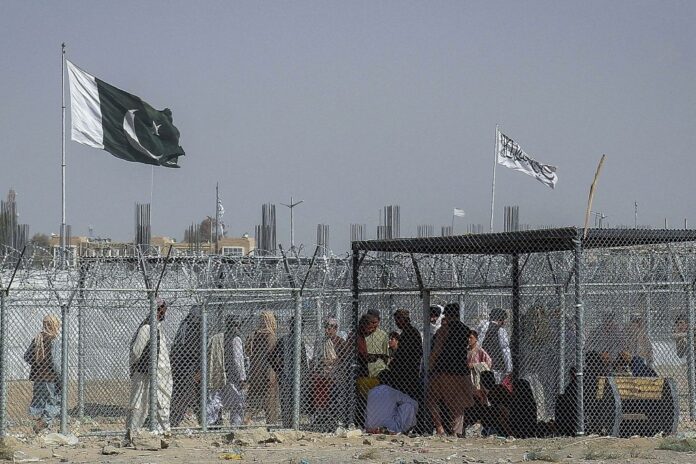LONDON: As Afghanistan’s Taliban celebrated 100 days in control of the country this week, they paraded dozens of US-built armoured vehicles through its cities. Unless it can end its international isolation, however, the country looks set to face its toughest winter in recent history.
Even before the Taliban takeover, drought, conflict and the impact of the COVID-19 pandemic were driving up humanitarian needs across the country.
Now run by Taliban authorities unrecognised by any nation as a legitimate government, the country remains frozen — not just from the rest of the world, but from what had previously been its savings, foreign-exchange reserves and access to international capital.
Perhaps fortunately for those now in power in Kabul, that pariah status is not as total as it might be. Major donors and institutions are continuing to talk to the Taliban, in some cases even authorising direct transfers to pay salaries. But that might not be enough to stave off catastrophe this winter.
On Monday, the United Nations Development Programme (UNDP) warned of a potential collapse of the Afghan banking system, saying the economic cost and social impact would be “colossal”.
The week before, the UN special representative for Afghanistan, Deborah Lyons, told the Security Council the country was “on the brink of a humanitarian catastrophe”.
The underlying problem is simple but also fundamental. Neither the international, nor Afghanistan’s own, banking, financial or humanitarian systems are designed to function in a country where the government is not just unrecognised and still viewed by much of the world as a dangerous terror group whose values — particularly on women and personal freedom — are starkly at odds with those espoused by the United Nations and other bodies.
Ultimately, as always, this face-off has competition for power at its core. The Taliban want legitimacy, the ability to rule the country as they wish while still being treated like any other government. The West and other potential backers want their own measure of control, both to limit how the Taliban behave domestically and avoid further backing for militants.
Also in the mix are international worries over Islamic State’s Afghan affiliate, sworn enemies of both the Taliban and West. On Monday, the United States announced new sanctions against individuals associated with Afghan IS elements, seeking to bar them from the international financial system even as it considers whether to readmit the Taliban.
CHINESE AID, WESTERN WORRIES
Where the Taliban of the 1990s looked to create an almost mediaeval society detached from the outside world, the more modern version wishes to engage, although it may have little choice in the matter. It is a process that inevitably poses challenges to all involved, and risks catastrophic misery for the ordinary people who are most affected.
The Taliban have put considerable effort into showing a more moderate face than when they ran the country in the 1990s, but reports of manhunts for those who supported Western forces and their ongoing bar on women in public and commercial life suggest their fundamental nature has not changed.
Even Pakistan and China, the former most supportive of the Taliban and the latter openly taking pleasure in the US defeat, have held back from recognising the Taliban outright.
China this week announced it was sending 1,000 tonnes of food by train and truck, as well as maintaining what it calls an “air corridor” for Afghan farmers to sell pine nuts and potentially other food to mainland China – but that will scarcely tackle the massive scale of the challenge.
Nor will the Taliban’s own efforts at domestic revenue generation. A spokesman last weekend said they were now creating more than $5 million a day across the country, with revenue of $288 million over the last 78 working days.
According to the United Nations, Afghanistan last year imported around $7 billion worth of goods and services, mostly foodstuffs. Billions of Afghan assets are tied up overseas, while the physical deliveries of US dollars to the country on which Afghan banks relied have ceased.
AFGHAN CREDIT CRUNCH
The result of that is as dangerous as it is predictable — an Afghanistan-only version of the late 2000s global credit crunch and the 2008 financial crisis. The United Nations estimates that many of Afghanistan’s banks might collapse within six months — although once such speculation mounts, it becomes self-fulfilling even faster.
Even when money now exists within the system, anxious Afghans are sitting on it. Of an estimated $4 billion of the Afghani currency believed to be within the economy, only about $500 million remains in circulation. Banks have ceased lending, and the United Nations says 67% of their loans within Afghanistan are now seen as non-performing, their repayment in jeopardy.
Having gradually regrown over the last two decades, Afghanistan’s banking system would likely need access to private capital as well as support from multilateral institutions such as the International Monetary Fund and World Bank to recover and survive. Whether the necessary willingness is there is another question – the signals remain mixed.
Earlier this month, the United Nations announced it had paid nearly $8 million in salaries directly to 23,500 Afghan health workers, bypassing the still-sanctioned Taliban. Other public sector salaries, however, have gone largely unpaid over the last three months.
On Saturday, Taliban authorities announced they would begin paying the backdated salaries. Where that money was to come from remained unclear — but the announcement followed a meeting with German and Dutch donors.
After 20 years of war, this is a more diplomatic dance. But if those involved are not careful this winter it could yet prove just as deadly.






















